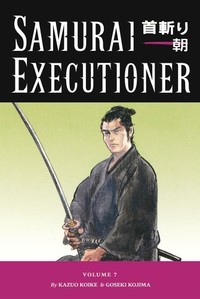Review
by Carlo Santos,Samurai Executioner
G.novel 7: The Bamboo Splitter
| Synopsis: |  |
||
Decapitator Asaemon may be the most renowned swordsman in Edo, but his job as a sword-tester/executioner has its downside. He can't attend the summer festival because of his association with death, although it helps him understand a criminal who's being executed during the celebrations. Ever the merciful killer, he laughs along when a convicted entertainer tells a joke as his last request; he spends the night with an old shaman in order to prove her sanity (insane criminals cannot be executed). A much tougher case emerges when Asaemon's policeman buddy, "Catcher" Kasajiro, must hunt down a serial killer called the Bamboo Splitter. Behind the elaborate crimes is an even more elaborate story that will leave the Edo police force stunned. |
|||
| Review: | |||
Although not as prestigious as its parent series Lone Wolf and Cub, Samurai Executioner is still a fine period drama—in manga or in any other medium. Anyone who's followed the series this far should be familiar with the pattern now: stories of varying length and minimal continuity, looking into the lives of Yamada Asaemon, his acquaintances, and his victims. Somehow, it never gets boring: creators Koike and Kojima always manage to find the emotional thread that pulls us into each story. If you've outgrown the sword-swinging fantasies that usually pass for historical adventure, then this is the next step up. Volume 7 starts out small, with three short stories taking up less than half the book. The first two in particular, "Heading to a Festival" and "The Last Performance," are more like mood pieces than full stories—they provide an appetizer for the main story that comes later. The saga of the Bamboo Splitter takes up the final two-thirds of the book, combining the best elements of the series by starting out as a crime thriller and closing with a deep character study. Mercurial policeman Kasajiro takes the spotlight for most of this arc and provides a welcome counterpoint to executioner Yamada's dryness. The volume's main weakness is its heavy reliance on flashbacks in the final chapter—a necessary device to explain the Splitter's back-story, but one that causes the reader to keep flipping back for details. Although Yamada is the central character in these tales, it's the characters around him who keep the stories moving. After six volumes, there isn't much more to explore about Yamada: he's the quintessential warrior, polite and stoic to a fault, and always gets the criminal's head in the end. No two criminals are alike, however, and it's their diverse stories that allow the reader (and Yamada) to reflect on life and death. Even though the sight of a severed head hitting the ground is familiar by now, it still makes you stop and think. When all that gravity gets too depressing, though, Kasajiro's detective work and crime-fighting exploits—often with Yamada's help—provide some high-energy thrills. The series' grave nature is reflected in Kojima's near-realistic gekiga artwork, dating back to the 1970's. Rather than looking old-fashioned, however, the art has a timeless feel: this is how feudal Japan has always looked, no matter how aesthetics may change elsewhere. Watch out for blood and nudity—the graphic content in this volume comes as a natural consequence, rather than cheap attempts to excite the reader. Despite the small page size and dense detail, the main characters are easily recognizable, although minor cast members go by in a blur. That same level of detail goes into the backgrounds; it takes nothing more than some thoughtful pen strokes to show atmospheres of day and night, hot and cold. The page layouts also keep the story moving smoothly—the orderly panels and minimal dialogue provide a solid visual rhythm, especially in action scenes. Samurai Executioner is one of the few manga titles in the U.S. that's still printed left-to-right, but Dark Horse's adherence to old-school ways doesn't hurt the story here. The volume is still perfectly readable in the flipped format, and the smaller page size isn't a problem—spacious paneling and quality printing help maintain the visual clarity. The translated dialogue is easy to follow in English, but still respects the Japanese language by preserving historical terms and defining them in a glossary. The sound effects are the only real hiccup—all Japanese effects in the artwork have been replaced by corresponding English ones, and seeing a comic-book "AAAH!" or "THUD" takes away from the cultural immersion. Being an executioner in feudal times may have been a grim job, but a well-crafted manga like this makes it a fascinating topic. Volume 7 maintains the high standard of the Samurai Executioner series, balancing out reflective short stories against a more action-oriented crime saga. With peerless law enforcers like Yamada and Kasajiro hunting down Japan's most devious criminals, the conflicts between good and bad are always a thrill in this classic historical drama. |
| Grade: | |||
|
Overall : A-
Story : A-
Art : A
+ Thoughtful stories, engaging characters and carefully detailed artwork. |
|||
| Production Info: | ||
|
Full encyclopedia details about Release information about |
||